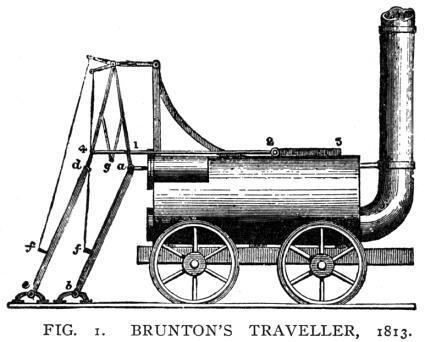Power type Steam Build date c. 1813 | Boiler pressure 40 lbf/in (280 kPa) | |
 | ||
Configuration Four wheels, not driven Loco weight 2 ⁄4 long tons (2.3 t; 2.5 short tons) | ||
The Steam Horse was constructed by the Butterley Company in Derbyshire in 1813 by William Brunton (1777–1851). Also known as the Mechanical Traveller, it had a pair of mechanical legs, with feet that gripped the rails at the rear of the engine to push it forwards at about three miles an hour.
Contents
Design
To modern readers it may seem a comical contraption, but it provides an interesting insight into railway thought at the time. The collieries were well served between towns by the canal system. From the pit head to the canals, horse-drawn wagonways had been constructed and steam engines were seen as no more than a noisy and dangerous novelty. However the Napoleonic Wars from 1799 to 1815 had brought a great increase in the price of fodder. Moreover, some such "railways" were being constructed on the steeper gradients within canals, as for instance on the Charnwood Forest Canal.
Nobody believed that steel wheels on smooth steel rails would give enough adhesion until Robert Stephenson and William Hedley proved otherwise in 1813 and even the former considered 1 in 100 (1%) was the absolute maximum grade. Consequently such steam operated systems as there were, were operated by cumbersome cables, or by the use of an expensive rack and pinion.
Crich
This makes Brunton's idea seem more reasonable, given that the Butterley Company were faced with a gradient of 1 in 50 between its Limestone quarry at Crich to the Cromford Canal at Amber Wharf, some 1.25 miles (2.01 km) away. Brunton took out a patent, No. 3700, dated 22 May 1813 for the locomotive. The Butterley locomotive cost a total of £240.
Newbottle
The historical record is scanty but it seems that the Steam Horse operated successfully for an unknown period. So much so, that another, larger, one seems to have been built for the Newbottle Colliery, in County Durham. This locomotive cost £540 and may have had two cylinders. During 1814 and 1815 it hauled loads up a 1 in 36 gradient at 3 miles per hour (4.8 km/h), but the colliery owners were not happy with it. On 31 July 1815, during a demonstration, the new wrought iron boiler exploded, killing thirteen spectators and injuring several others, and the idea was not pursued. This incident was the first recorded railway disaster.
